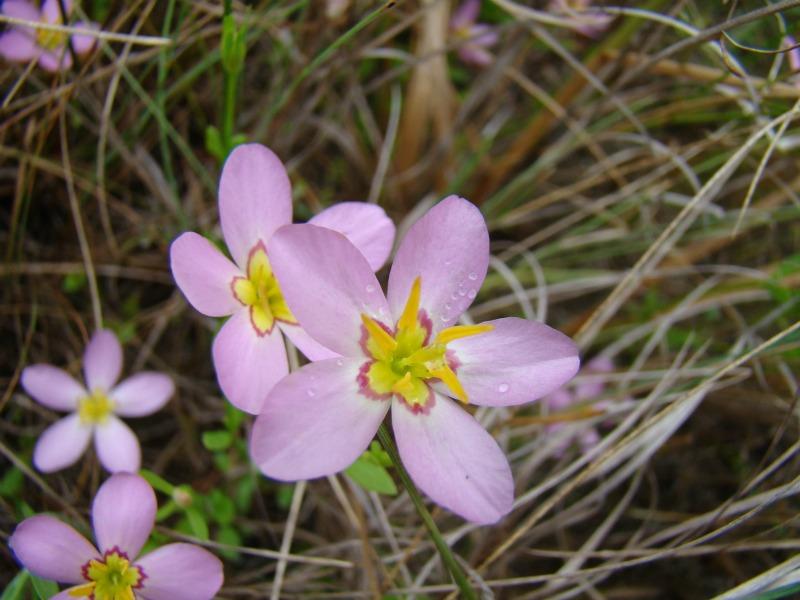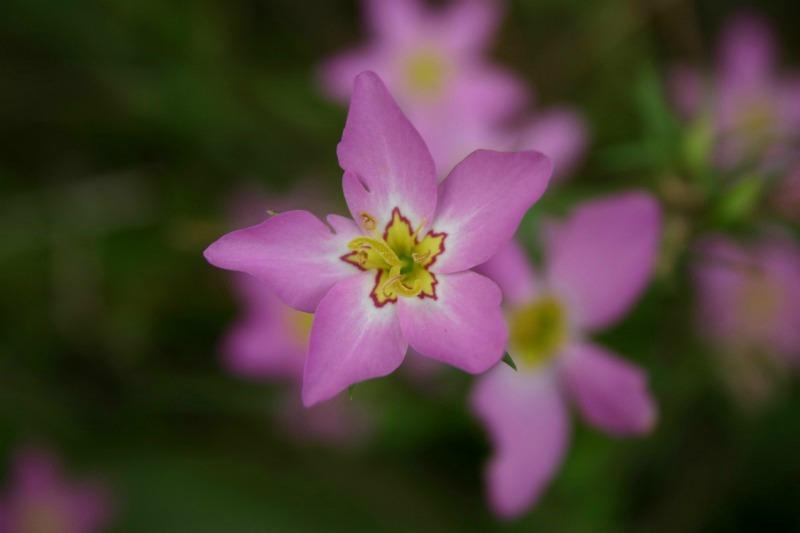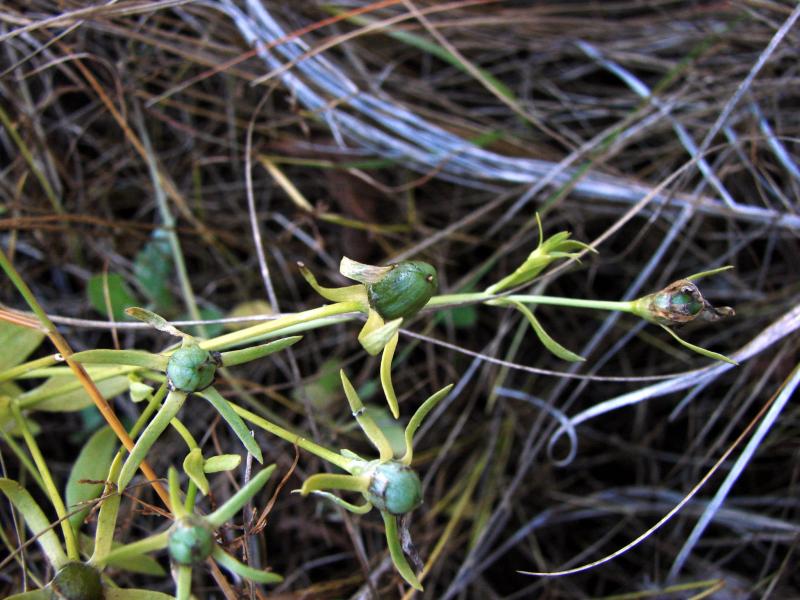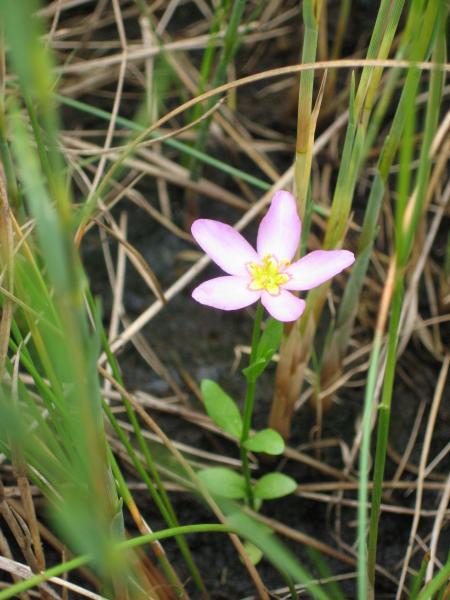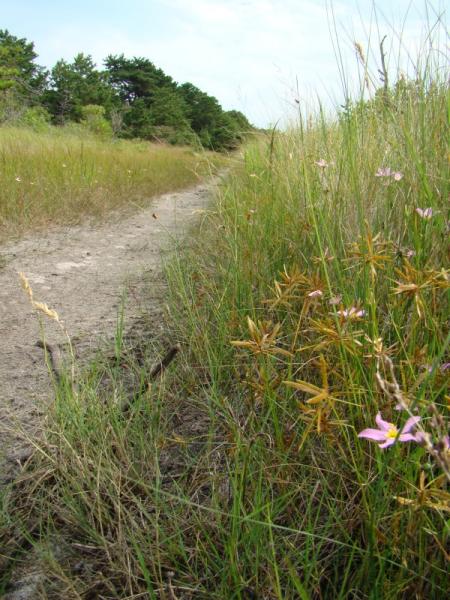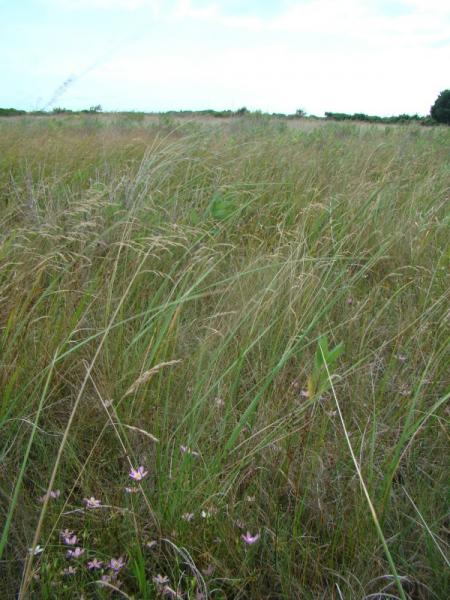Sea Pink
Sabatia stellaris Pursh
- Class
- Dicotyledoneae (Dicots)
- Family
- Gentianaceae (Gentian Family)
- State Protection
- Threatened
Listed as Threatened by New York State: likely to become Endangered in the foreseeable future. For animals, taking, importation, transportation, or possession is prohibited, except under license or permit. For plants, removal or damage without the consent of the landowner is prohibited.
- Federal Protection
- Not Listed
- State Conservation Status Rank
- S2
Imperiled in New York - Very vulnerable to disappearing from New York due to rarity or other factors; typically 6 to 20 populations or locations in New York, very few individuals, very restricted range, few remaining acres (or miles of stream), and/or steep declines.
- Global Conservation Status Rank
- G5
Secure globally - Common in the world; widespread and abundant (but may be rare in some parts of its range).
Summary
Did you know?
The species name means star and this beautiful wildflower is really the star of the salt marsh with its stunning pink and yellow flowers visible from midsummer into the fall.
State Ranking Justification
There are seven existing populations with hundreds of plants each. Three of the populations are threatened by Phragmites. There are 17 historical populations known from the late 1800s through the 1970s which have not been rediscovered. Two other populations are now considered extirpated.
Short-term Trends
The short-term trends are not fully known. Three of the seven existing populations have been resurveyed and seem stable. More surveys for the remaining populations are needed to determine the trend.
Long-term Trends
The long-term trend is apparantly negative. Most of the historical collections of this species are from New York City and western Long Island, where much of the salt marsh habitat has been destroyed or severely impacted. This species has likely declined over the last century, although additional surveys of historical sites are needed.
Conservation and Management
Threats
Invasion of salt marshes or brackish meadows by European common reed (Phragmites australis ssp. australis) is a threat to some populations. Ditching and other human impacts to hydrology or water quality are threats at some sites as well. The impact of sea-level rise on high salt marsh communities and their constituent rare species (including Sea-pink) is a potential threat.
Conservation Strategies and Management Practices
Control Phragmites invasions in the salt marshes that support this species and prevent any new incursions. Natural buffers should be established around the salt marshes to decrease pollution runoff and other direct human disturbances.
Research Needs
Research is needed to determine techniques for the successful augmentation of populations after Phragmites removal.
Habitat
Habitat
In New York, Sea Pink has been most often collected from areas of high salt marsh. It also can be found in wet, brackish habitats such as interdunal swales, brackish meadows, and ponds (New York Natural Heritage 2011). Salt or brackish marshes along the coast (Gleason and Cronquist 1991).
Associated Ecological Communities
- Brackish interdunal swales
(guide)
Temporarily tidally flooded temperate marshes in interdunal swales dominated by salt-tolerant graminoids. Individual swales occur as small patches positioned between fore-, primary and secondary dunes in a maritime dunes system, typically on barrier islands.
- Brackish meadow
(guide)
A moist, moderately well-drained brackish (salinity 0.5-18 ppt) perennial grassland with occasional isolated shrubs that is typically situated in a belt at the upper edge of salt marshes bordering sandy uplands, but may occupy large portions of interdunal basins. The community usually develops in areas with a unique combination of soils and hydrology, on deep deposits of periodically windblown or overwashed gleyed sands that are usually flooded only during spring tides and during major coastal storms, approximately two to three times per year.
- High salt marsh
(guide)
A coastal marsh community that occurs in sheltered areas of the seacoast, in a zone extending from mean high tide up to the limit of spring tides. It is periodically flooded by spring tides and flood tides. High salt marshes typically consist of a mosaic of patches that are mostly dominated by a single graminoid species.
Associated Species
- Agalinis maritima
- Atriplex patula (spear orach)
- Baccharis halimifolia (groundsel-tree)
- Distichlis spicata (salt grass)
- Iva frutescens (salt marsh-elder)
- Juncus bufonius (common toad rush)
- Juncus canadensis (Canada rush)
- Juncus gerardii
- Limonium carolinianum (sea-lavender)
- Mollugo verticillata (carpetweed)
- Myrica gale (sweet gale)
- Panicum virgatum (switch grass)
- Plantago maritima var. juncoides (seaside plantain)
- Polygala verticillata (whorled milkwort)
- Salicornia bigelovii (Bigelow's glasswort)
- Salicornia depressa (slender glasswort)
- Salsola kali
- Solidago sempervirens (northern seaside goldenrod)
- Spartina alterniflora (smooth cord grass)
- Spartina patens (salt-meadow cord grass)
- Strophostyles helvula
- Toxicodendron radicans
Range
New York State Distribution
This saltmarsh wildflower is known from Nassau and Suffolk counties on Long Island but extirpated farther west in Queens and Brooklyn. There is also an historical record from Staten Island.
Global Distribution
This saltmarsh wildflower grows along the Atlantic and Gulf coasts from Southern New England and New York, where it is rare, south to Florida and west to Louisiana.
Identification Comments
General Description
Sea-pink is an annual herb in the gentian family. Its stem may be up to 60 centimeters tall, with opposite leaves. The middle leaves of the main stem are 2 to 4 centimeters long, entire and oblanceolate, and taper to the base. The upper leaves are linear and tapered to the base. The striking flowers are pink (sometimes white) with a yellow center, its petals are 9 to 18 millimeters long, exceeding the lobes of the calyx. The fruit are capsules. (Gleason and Cronquist 1991)
Best Life Stage for Proper Identification
Flowering specimens or fruiting specimens are best.
Similar Species
Sabatia stellaris is most similar to S. campanulata. S. campanulata differs by being a perennial species growing from a thick caudex, by having leaves with a broad, sessile base, by the calyx lobes equaling the corolla, and by the lateral peduncles having 1 or 2 bracts (S. stellaris has bractless peduncles). (Enser 2004, Gleason and Cronquist 1991)
Best Time to See
Sea-pink flowers in August and September and a few blooms may persist into October.
- Flowering
- Fruiting
The time of year you would expect to find Sea Pink flowering and fruiting in New York.
Sea Pink Images
Taxonomy
Sea Pink
Sabatia stellaris Pursh
- Kingdom Plantae
- Phylum Anthophyta
- Class Dicotyledoneae
(Dicots)
- Order Gentianales
- Family Gentianaceae (Gentian Family)
- Order Gentianales
- Class Dicotyledoneae
(Dicots)
- Phylum Anthophyta
Additional Common Names
- Marsh-pink
Synonyms
- Stellaria amoena (Raf.) G. Don
Additional Resources
Best Identification Reference
Gleason, Henry A. and A. Cronquist. 1991. Manual of Vascular Plants of Northeastern United States and Adjacent Canada. The New York Botanical Garden, Bronx, New York. 910 pp.
Other References
Clemants, Steven and Carol Gracie. 2006. Wildflowers in the Field and Forest. A Field Guide to the Northeastern United States. Oxford University Press, New York, NY. 445 pp.
Crow, Garrett E. and C. Barre Hellquist. 2000. Aquatic and Wetland Plants of Northeastern North America: A revised and enlarged edition of Norman C. Fassett's a Manual of Aquatic Plants. Volume One: Pteridophytes, Gymnosperms, and Angiosperms: Dicotyledons. The University of Wisconsin Press. Madison, Wisconsin. 536 Pages.
Enser, Richard. 2004. Sabatia stellaris Pursh Sea pink Conservation and Research Plan
for New England. New England Wildflower Society. Framingham, MA
Holmgren, Noel. 1998. The Illustrated Companion to Gleason and Cronquist's Manual. Illustrations of the Vascular Plants of Northeastern United States and Adjacent Canada. The New York Botanical Garden, Bronx, New York.
Mitchell, Richard S. and Gordon C. Tucker. 1997. Revised Checklist of New York State Plants. Contributions to a Flora of New York State. Checklist IV. Bulletin No. 490. New York State Museum. Albany, NY. 400 pp.
New York Natural Heritage Program. 2010. Biotics database. New York Natural Heritage Program. New York State Department of Environmental Conservation. Albany, NY.
New York Natural Heritage Program. 2024. New York Natural Heritage Program Databases. Albany, NY.
Newcomb, Lawrence. 1977. Newcomb's Wildflower Guide: An Ingenious New Key System for Quick, Positive Field Identification of the Wildflowers, Flowering Shrubs, and Vines of Northeastern and North-Central North America. Little, Brown and Company. Boston.
Weldy, T. and D. Werier. 2010. New York flora atlas. [S.M. Landry, K.N. Campbell, and L.D. Mabe (original application development), Florida Center for Community Design and Research http://www.fccdr.usf.edu/. University of South Florida http://www.usf.edu/]. New York Flora Association http://newyork.plantatlas.usf.edu/, Albany, New York
Links
About This Guide
This guide was authored by: Stephen M. Young, Richard M. Ring.
Information for this guide was last updated on: March 7, 2013
Please cite this page as:
New York Natural Heritage Program. 2024.
Online Conservation Guide for
Sabatia stellaris.
Available from: https://guides.nynhp.org/sea-pink/.
Accessed July 27, 2024.
